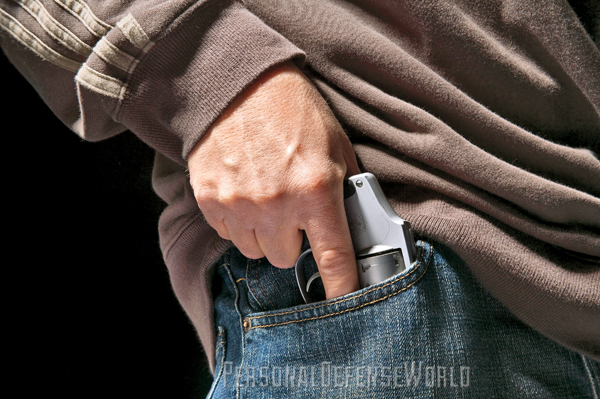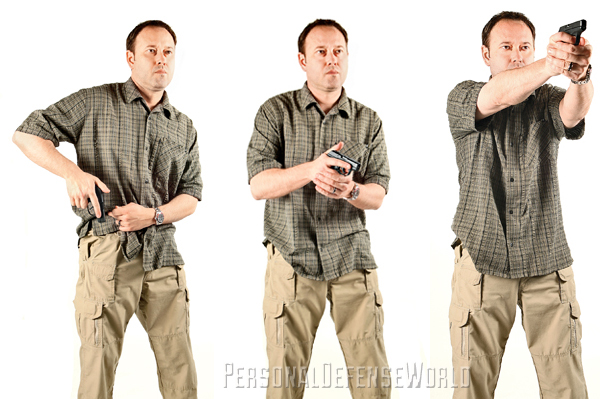If you carry a handgun for personal protection, getting your gun into the fight iS A critically important part of your skill set. With a traditional belt or inside-the-waistband (IWB) holster, these tasks can be a challenge. However, if you carry your pistol deeply concealed—like in a pocket—life can get even more complicated very quickly.
A sound, effective and reliable drawstroke begins with a capable carry platform that reliably keeps your concealed handgun in a stable, consistent position. The gun should also be well protected from both objects and errant digits that could compromise its safety or reliability. This is particularly important with in-pocket carry, which restricts your ability to achieve an initial grip on the gun and potentially puts the gun in close proximity to other objects. To avoid the latter issue and make life much easier, start by dedicating your gun pocket to your gun (and its holster) only—nothing else.
Pocket Holsters
Despite their name, pocket pistols should not just be dropped into a pocket. Carried loose, small handguns tend to settle in inconvenient, uncomfortable positions that are not conducive to a quick or safe draw. Instead, they should be carried in a properly designed pocket holster that not only protects the gun and its trigger, but also supports it to keep it in a safe, predictable orientation. To do this, most pocket holsters are shaped to fill the entire outline of the pocket. This sometimes leaves very little, if any, room above the mouth of the holster for the fingers to wrap around the grip during the draw.
Advertisement — Continue Reading Below
Pocket holsters also typically have some type of design feature that helps keep them in the pocket while the gun is drawn. This may be rough-side-out suede, a rubberized texture, or an integral “hook” that snags the inside of the pocket as the pistol is drawn. When properly manufactured, these features also help hold the holstered gun in a consistent, accessible position.
When choosing a pocket holster, look for one that supports your preferred carry gun in a safe, consistent position, covers the triggerguard, and allows as complete a grip as possible on the gun while it is still in the holster. Then, once you think you’ve found a good pocket holster, put your loaded gun into it and carefully try it out in all the different styles of pants you wear. Don’t worry about drawing yet; just make sure it fits their pockets consistently, conceals well and carries comfortably. If you want to carry regularly (as you should), you need to make sure it fits the pockets of everything you actually wear.
Build Your Draw
Now that you’ve narrowed your wardrobe to pants that will work with pocket carry, it’s time to start building your draw. Initially, it’s best to do this with an empty gun, so find a safe, controlled area and clear your pistol before you begin.
Advertisement — Continue Reading Below
The first step in building a draw is to confirm that your pocket is actually large enough to allow the combined package of your hand and pistol to exit smoothly. Holster your empty gun and put it in your pocket in its planned carry position. Then, reach your hand into your pocket, achieve the most complete grip possible on the gun and, with good trigger-finger discipline, attempt to draw the gun out of your pocket. As you do, take note of any snagging of your hand or the gun that would impede your draw when done at speed.
If your hand and gun comes out of your pocket smoothly, you’re on a roll. However, if your hand binds at the top of the pocket or if you find it difficult to achieve a solid grip on the gun while still in the pocket, you have some more work to do.
To allow your hand to clear the pocket more smoothly, you’ll need to flatten the profile of your hand/gun package. If your holster provides enough space between the holster mouth and the gun’s grip, hook your middle, ring and little fingers around the grip as usual, but place your thumb on top of the gun. This reduces the thickness of your hand and shrouds the top of the gun, allowing your thumb to act as a “ramp” to smooth the draw.
Advertisement — Continue Reading Below
If your holster won’t allow a traditional three-finger grip, grip the pistol with the web of your thumb high on the backstrap and pinch the grip hard between your thumb and palm, keeping all your fingers straight. Maintaining this grip, lift the gun out of your pocket until the grip clears the pocket top and then curl your three fingers to complete your grip.
Work through this process slowly and carefully starting with your hand on the holstered pistol. With practice, you’ll be able to “round off the corners” and achieve a safe, smooth, reliable draw. As you do this, develop the habit of removing the holster from your pocket after every draw and reholstering the gun outside the pocket. Never attempt to replace a pistol in a holster that’s still in your pocket.
Once you’re comfortable with the mechanics of actually drawing the gun from the pocket, you should develop the ability to get your hand into your pocket quickly. The easiest way to do this is to learn to “prep” your draw by casually sliding your hand into your pocket at the first sign of trouble. Using those mechanics as a foundation, the next step is to increase the speed of getting your hand into the pocket and on the gun. As you do, you’ll need to sort through the details of clearing jackets, shirts, or anything else you wear that may cover the top of your pocket. My preferred method for doing this is to hook the bottom of my shirt with my curled fingers, and pull up and back, stretching the shirt around my waist. You can then pin the shirt to your hip with the inside of your wrist to hold it in place as your hand drives into your pocket. The advantage of this method over the traditional two-handed approach is that it enables you to draw one-handed, freeing your non-gun hand to defend, strike, grab, or gouge—all necessary supporting tactics when fighting at close range.
Advertisement — Continue Reading Below
When you’ve finally sorted out all the mechanics of getting the gun out of your pocket and into your hand, work on integrating them into your other shooting skills and tactics. In the process, adapt your tactics as necessary to fit your chosen weapon and style of carry. By following this logic, you can create a personal pocket-pistol system that you can trust.
BUY NOW! AT www.personaldefenseworld.com/subscribe/pocket-pistols.
























